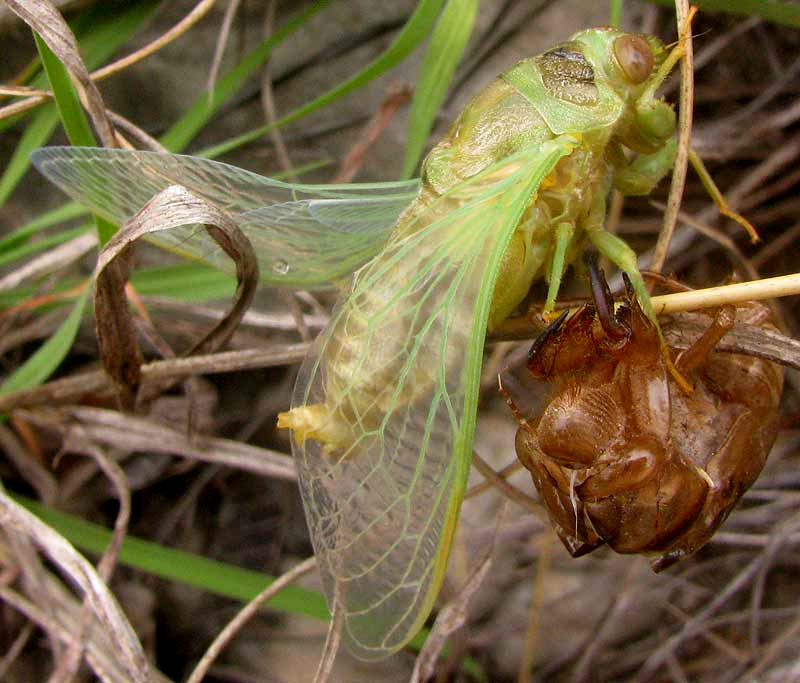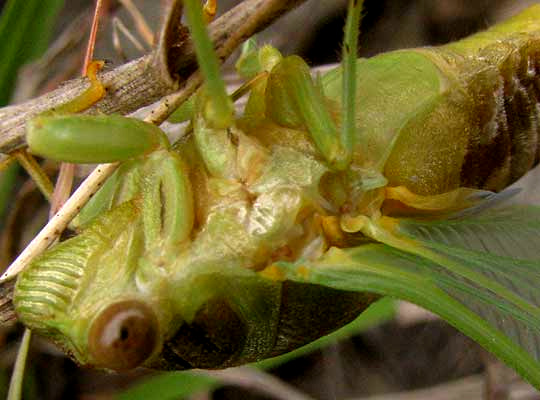Excerpts from Jim Conrad's
Naturalist Newsletter

from the May 25, 2014 Newsletter issued from the Frio Canyon Nature Education Center in the valley of the Dry Frio River in northern Uvalde County, southwestern Texas, on the southern border of the Edwards Plateau; elevation ~1750m (~5750 ft); N29.62°, W99.86°; USA
ANNUAL CICADA EMERGING
Something caught my eye in tall grass in a wild stretch of the upper Dry Frio Valley. It turned out to be a black, shriveled and half decomposed mushroom, but beside that -- well camouflaged and unseen until my hand grazed it -- was what's shown above. Another picture, closer up, appears below.

That's a very young cicada freshly emerged from its brown exoskeleton, which dangles from the straw below the cicada. You can see that the cicada is so recently emerged that its wings are still so pliable that they bend easily without fracturing. I've never seen any cicada species with this one's green and yellow hues, but freshly emerged individuals often are colored different from how they will appear as adults. Not knowing the species, it's just unclear whether this will be a greenish yellow adult or not.
Volunteer identifier Bea in Ontario submitted the pictures to BugGuide.Net, and before the day was out Bill Reynolds in Raleigh, NC commented that "... it might be a teneral Tibicen sp. (perhaps one of the smaller western species)."
The nice word "teneral" is an adjective describing the stage when an adult insect is newly emerged from the pupal case or nymphal skin and not yet functioning as an adult. "Tibicen" is a cicada genus embracing species known as annual cicadas. Since Bill is the Curator of the Arthropod Zoo at the North Carolina Museum of Natural Sciences, I figure that his designation as a "teneral Tibicen" is about as far as we're going get with this identification.
That last picture, with the cicada upside-down beneath his straw, shows some interesting features not usually seen in normal cicada views. For example, to the left of the brownish abdomen segments in the picture's top, right corner, there are two large, thumbnail-shaped scales, or plates. The darker, bottom one is the "tymbal cover," which covers the membrane-like tymbal, which is connected to a tymbal muscle. The muscle can contract and release very fast causing the tymbal to vibrate about 4,000 times per second. This vibration creates a sound, the loudness of which is increased inside the cicada's somewhat hollow abdomen, which serves as a resonator. This loud rattling sound is then radiated by the tympana.
In our picture, the tympana are covered by the large, greenish plate above and to the left of the tymbal cover (It'd be "below" if the cicada weren't upside-down). That plate is the operculum, which protects the delicate tympana beneath it. Females, not having to call, don't have large tymbals and typana, so they display much smaller operculums than ours has. Before long, our male should be drumming loudly from a neighborhood tree.